State of Observability 2021 Report Links Observability Best Practices With Successful Digital Transformation
Splunk (NASDAQ: SPLK) has released a report titled The State of Observability 2021, revealing key findings on observability's role in digital transformation. The report emphasizes that organizations prioritizing observability experience significant benefits, including 2.9 times better visibility into application performance and 4.5 times more successful digital transformation initiatives. However, gaps in observability are linked to tangible business losses, with 45% of respondents citing lower customer satisfaction and 37% facing revenue loss due to service failures. The global survey included over 525 IT leaders.
- Mature observability users report 2.9 times better visibility into application performance.
- Organizations with advanced observability are 4.5 times more likely to achieve successful digital transformations.
- Leaders see 60% more new services and revenue streams compared to beginners.
- 45% of respondents reported lower customer satisfaction due to service failures.
- 37% experienced revenue loss attributed to inadequate observability practices.
- 30% faced a loss of customers as a consequence of service disruptions.
Insights
Analyzing...
Splunk Inc. (NASDAQ: SPLK), provider of the Data-to-Everything Platform, in collaboration with Enterprise Strategy Group, today announced The State of Observability 2021, a global research report that explores what a strong, high-level observability practice looks like and the meaningful results observability can deliver in the Data Age. With every organization now being a digital organization, the report shows that observability should be viewed as a core competency, not a cutting-edge differentiator.
The research finds that observability delivers tangible, essential results and high maturity observability practices are correlated with:
- Much greater visibility across hybrid, multi-cloud infrastructures, resources and performance areas. Mature observability users are 2.9 times as likely to report better visibility into application performance and enjoy almost two times better visibility into public cloud infrastructure.
-
Accelerated root cause identification, meaning complex, service-crashing crises are fixed much more quickly, or averted entirely. Leaders are 6.1 times likelier to have accelerated root cause identification (
43% of leaders versus7% of beginners). - Faster digital transformation, with more successful results. Organizations with the most advanced observability practices are 4.5 times more likely to report successful digital transformation initiatives.
-
Exploding innovation, with leaders reporting
60% more new services, products and revenue streams than organizations with beginner-level observability.
“The pandemic accelerated digital transformations this past year and observability simply is no longer optional in a real-time economy where multicloud complexity has become standard,” said Sendur Sellakumar, Senior Vice President, Cloud and Chief Product Officer, Splunk. “Having a robust observability practice means fewer service disruptions, better customer experiences and more successful digital transformations. Observability means full fidelity data visibility not only at the infrastructure level, but also at the application and service level, with end-to-end transaction visibility no matter the technologies involved.”
A significant percentage of respondents also say they have suffered material consequences for service failures that better observability practices could have prevented:
-
Lower customer satisfaction (
45% ) -
Loss of revenue (
37% ) -
Loss of reputation (
36% ) -
Loss of customers (
30% )
Additionally, gaps in observability hurt the bottom line and customer satisfaction:
-
53% of leaders reported that app issues have resulted in customer or revenue loss. -
45% reported lower customer satisfaction as a result of service failures. -
30% reported losing customers as a consequence.
The report is the second in a series, after Splunk recently released The State of Security 2021, which included early input from security leaders after the revelation of the SolarWinds attacks. The State of Observability 2021 also highlights concrete recommendations for organizations as they look to improve their observability practices, including prioritizing data collection and correlation, as well as making use of AI, ML and automation.
Methodology
The global survey was conducted from mid-February through mid-March 2021 and in partnership with the Enterprise Strategy Group. The 525 respondents, IT and ITOps leaders and practitioners, were drawn from nine global regions and from organizations with more than 500 employees and an existing observability practice.
About Splunk Inc.
Splunk Inc. (NASDAQ: SPLK) turns data into doing with the Data-to-Everything Platform. Splunk technology is designed to investigate, monitor, analyze and act on data at any scale.
Splunk, Splunk>, Data-to-Everything, D2E and Turn Data Into Doing are trademarks and registered trademarks of Splunk Inc. in the United States and other countries. All other brand names, product names, or trademarks belong to their respective owners. © 2021 Splunk Inc. All rights reserved.
View source version on businesswire.com: https://www.businesswire.com/news/home/20210615005372/en/







